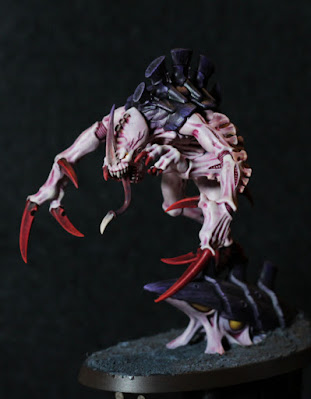 |
| Armed and armoured. |
Finally some more of Horus has been painted. There's not a whole lot of information to add, so the focus for this post is on the talon metallics.
The sculpt itself has some excellent designs that lend naturally to NMM approaches for the talon, so I decided to keep with that, but use metallic paints. The key behind NMM is contrast: bright points next to dark shadows, and a range of paints were mixed in to try and create the various shades. Quite a bit of back and forth, but it went something along the lines of:
- Iron Hands Steel across all silver metal areas.
- Leadbelcher, thinned a little, as a first stage highlight. This was mixed with some Iron Hands Steel on the palette to help smooth this out.
- Basilicanum Grey (Contrast) mixed with some Contrast Medium to further darken some areas, or cover an area entirely (such as the bolter casing).
- Ironbreaker, thinned a little, to further highlight areas. Mixed with some of whatever was on the the palette to try have smooth transitions in places, but also unevenly dragged along edges to create a sharp highlight.
- Stormhost Silver along edges, tips, or corners just for bright highlight points.
- Grey Knights Steel on selected points ("bumps" along the inner talon, and the very tips of the talons). This is yet another reflection of Horus being the opposite of what the Imperium was intended; as the Grey Knights are armoured, Horus uses such a thing for weapons instead.
The uneven highlighting adds a little more variation to the model, gives characters, mimics scratches and wear. Horus has obviously kept his equipment in excellent condition, but has used it, and this uneven edge highlighting tricks the viewer into seeing it with more realism.
Still a very long way to go before this model is finished.
 |
| Horus about to "mic drop". |
-- silly painter.










































